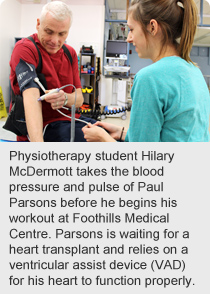
December 12, 2012
Story and Photo by Colin Zak
You’d never guess Paul Parsons is waiting for a heart transplant.
Twice a week, the 56-year-old – along with several patients like him – runs on the treadmill and lifts weights at the Foothills Medical Centre rehabilitation gym.
 “When I first came here, I couldn’t walk up a set of stairs without a break,” says Parsons, who suffered heart failure in August when his heart swelled to three times its normal size.
“When I first came here, I couldn’t walk up a set of stairs without a break,” says Parsons, who suffered heart failure in August when his heart swelled to three times its normal size.
“Now I can go on a 30-minute walk without a problem.”
The patients at the gym have had a variety of heart problems but they all have one thing in common: they all rely on ventricular assist devices (VAD) to keep them alive while they are waiting for heart transplants. The device is a mechanical circulatory unit attached to the heart that helps a failing ventricle pump blood through the body. The VAD is attached to an external battery unit which patients wear around their waist 24/7.
“If I didn’t have a VAD, I’d be six feet under,” Parsons says. “These classes keep me healthy and give us all a sense of camaraderie with other guys in the same situation.”
The VAD gym program, operated by Alberta Health Services, has been working with patients like Parsons since 2006, when teams at Libin Cardiovascular Institute of Alberta first began implanting the devices in patients.
“Without VADs, these patients would deteriorate,” says nurse clinician Bonnie Baptie, who cares for many of the patients who use the VAD rehabilitation program. “The VAD gym we operated gets patients healthy and strong so that when they do get called for a transplant, they’ll be able to bounce back.”
However, Baptie says the benefits aren’t only physical.
“It’s a great support group for these patients, as well as their families who often come along,” she says.
Dr. Debra Isaac, Director of the Cardiac Transplant Clinic at Foothills, says VADs have dramatically increased survival rates for patients with a variety of cardiac conditions.
“Many of these patients were on the edge of survival before they received a VAD,” Isaac says.
“The device allows them to be at home rather than hospital, extending both their quantity and quality of life.”
Parsons agrees.
“I’m doing things I would have never thought possible. I feel great,” he says.